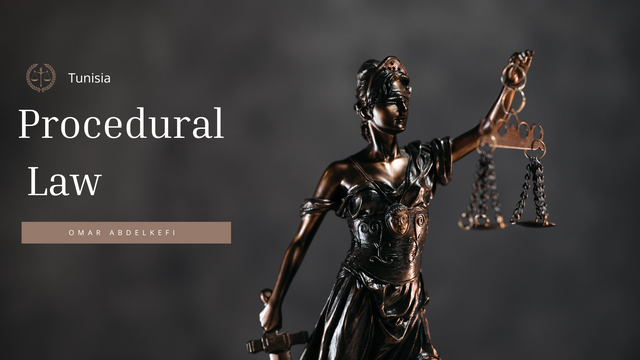SLC22-W4 / Procedural Law
By Omar from Tunisia
🌟 SLC22-W4 / Procedural Law 🌟

Image Source: canva
Part I: Procedural Law in Tunisia

Image Source: freepik
A. Law Chosen: Code of Civil and Commercial Procedures (CPCC)
In Tunisia, the law of Code of Civil and Commercial Procedures serves as a model for Procedural Law; it governs court docket proceedings for resolving civil and business disputes, masking everything from the initiation of complaints to the trial process, together with the presentation of proof and the execution of judgments.
Here’s the thing that I consider this an Procedural Law because it focuses on the process and procedure of resolving legal disputes rather than defining substantive rights , For example . it doesn’t say what constitutes a breach of contract . (that’s substantive law) but i will explains how to file a lawsuit for breach of contract.
B. Principles of Procedural Law in the CPCC
The CPCC incorporates several principles of Procedural Law Let’s break it down:
- Principle of Equality: Both parties in a lawsuit have equal opportunities to present their case. For example, both the plaintiff and defendant can submit evidence and call witnesses.
- Principle of Legality: All the court procedures must follow the law. Judges and parties cannot deviate from the CPCC’s rules.
- Principle of Economy: The CPCC ; encourages efficient processes to avoid unnecessary delays and expenses. For instance courts can dismiss frivolous lawsuits early to save time and resources.
- Principle of Publicity: Court hearings are generally public, ensuring transparency. However, certain cases (e.g., family disputes) may be private to protect sensitive information.
Part II: Practical Case – Mr. Ramírez vs. Mr. Pérez

Image Source: freepik
Facts of the Case
- Mr. Ramírez rents a commercial premises to Mr. Pérez.
- Mr. Pérez uses the premises as a residence, violating the contract.
- Mr. Ramírez sues for contract termination and requests a judicial inspection.
- The court schedules the inspection.
A. Process vs. Procedure
- Process: The method refers to the overall legal movement, which in this example is the lawsuit filed by Mr. Ramírez to terminate the agreement because of breach. It consists of all steps from filing the lawsuit to the very last judgment.
- Procedure: The procedure refers to the specific steps within the process. For example, the judicial inspection requested by Mr. Ramírez is a procedural step. The court’s scheduling of the inspection (day, time, and date) is also part of the procedure.
Part III: Practical Case – María vs. Pedro

Image Source: freepik
Facts of the Case
- María’s vehicle brakes fail, causing a collision with Pedro’s vehicle.
- Pedro sues María for damages.
- After filing the lawsuit, Pedro discovers the vehicle belongs to Mr. Manuel.
A. Procedural Subjects
- Plaintiff (Active Subject): Pedro is the plaintiff because he is the one filing the lawsuit to claim damages.
- Defendant (Passive Subject): Initially, María is the defendant as she was driving the vehicle. However, after discovering the vehicle belongs to Mr. Manuel, he may also become a defendant if he is found liable.
- Judge: The judge oversees the case, ensuring the process follows the law and issuing a final judgment.
- Third Party: Mr. Manuel could be a third party if he is brought into the case due to his ownership of the vehicle.
Conclusion
Procedural Law is essential for ensuring that criminal disputes are resolved pretty and efficiently. Through the Code of Civil and Commercial Procedures (CPCC), Tunisia has established a framework that upholds standards like equality, legality, and economy. Understanding the difference between process and procedure helps us navigate the legal system effectively.
I hope you enjoyed my post! I invite my friends @bimanakhan, @prudence21, and @mrimpian to join this challenge and share their insights on Procedural Law.
Resources
- Code of Civil and Commercial Procedures (CPCC) - Tunisia
- Principles of Procedural Law - Legal Encyclopedia
My introduction post on Steemit: link
About the Author
👋 Hi, I’m Kafio!
Software Engineer | Data Science Enthusiast | Trading Buff | Development Geek | Computer Science Lover 💻📊📈
I’m passionate about exploring the intersection of technology and innovation, with a special interest in data science, trading, and software development. Whether it’s diving into the latest in computer science or developing new projects, I’m always excited to learn and share insights. 🚀
I also love to travel
Got questions or just want to connect? Feel free to reach out to me at: [email protected] 🌟

The post is shared on Twitter: Twitter Link.
Downvoting a post can decrease pending rewards and make it less visible. Common reasons:
Submit